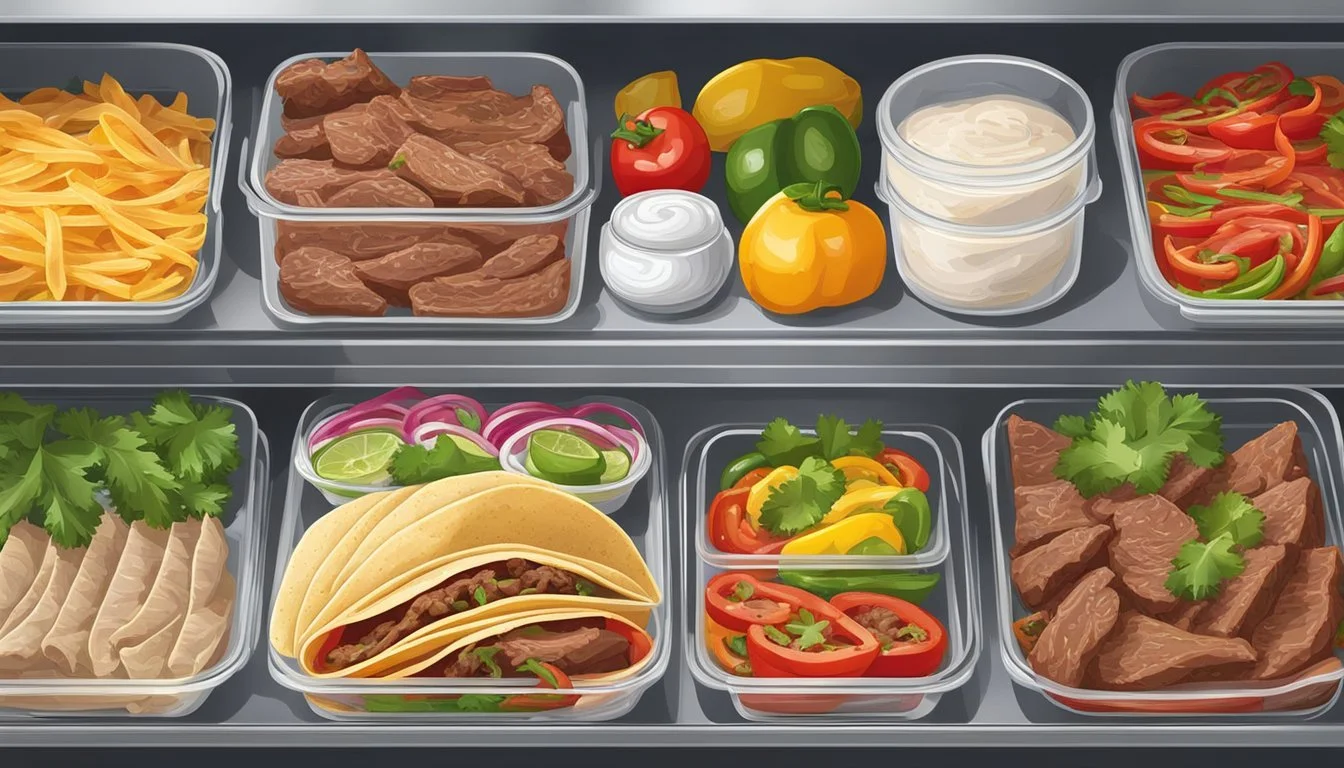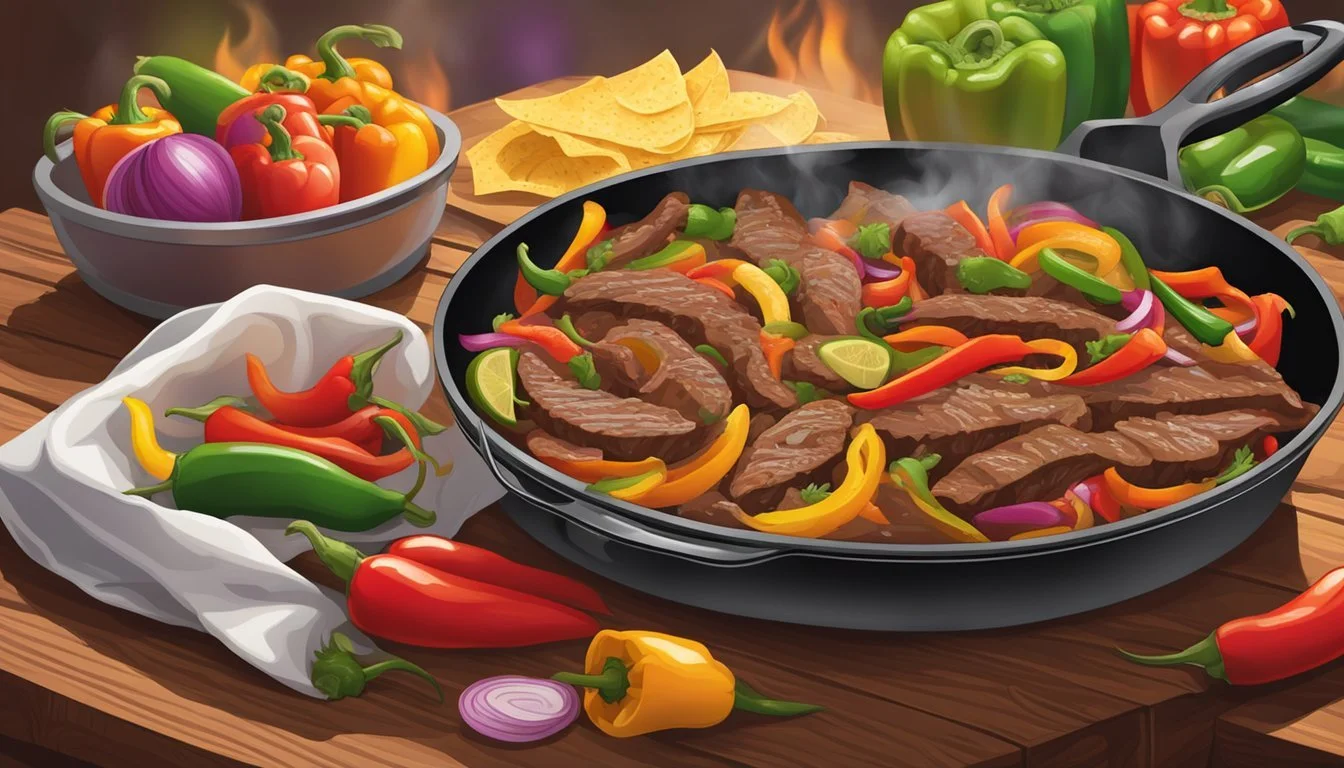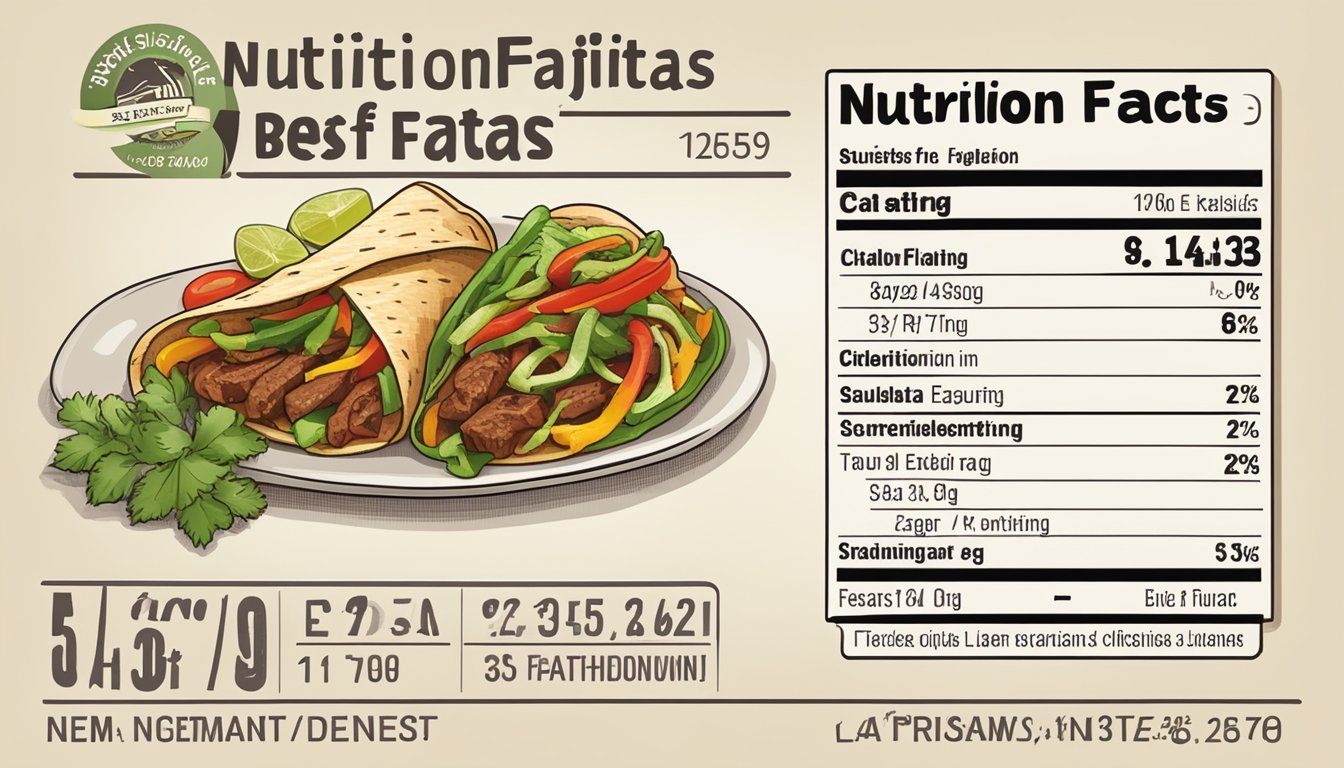How Long Do Beef Fajitas Last?
Storage Tips and Shelf Life
Beef fajitas make for a delicious and convenient meal option, but knowing how long they last is crucial for ensuring you enjoy them safely. When stored properly in an airtight container in the refrigerator, beef fajitas can last up to 5 days. This includes all components, such as the marinated beef, the sautéed vegetables, and any assembled tortillas.
Marinade plays a vital role in tenderizing the beef and adding flavor, but it doesn't significantly change the shelf life. Accompaniments such as salsa, guacamole, and sour cream typically have shorter shelf lives once prepared. For instance, guacamole can turn brown due to oxidation in just 2-3 days, even when properly stored.
When storing beef fajitas, make sure to separate the beef and vegetables from the tortillas to avoid sogginess. This ensures that each component maintains its texture and flavor, allowing you to enjoy the perfect fajita even days after your initial meal prep.
Understanding Beef Fajitas
Beef fajitas are a flavorful and popular dish that combines seasoned beef with vibrant vegetables. The taste and texture greatly depend on the ingredients and preparation methods used.
Components of Beef Fajitas
Beef fajitas typically include three main components: beef, peppers, and onions.
Beef: The beef is often marinated to enhance its flavor and tenderness.
Peppers: Bell peppers, usually red, yellow, or green, add color and a slightly sweet taste.
Onions: Onions complement the peppers with their slightly pungent flavor, making the dish well-balanced.
These ingredients are sliced thinly and cooked together, usually grilled or sautéed, to create a harmonious blend of flavors and textures.
Popular Beef Cuts for Fajitas
The choice of beef cut is crucial for achieving the right texture and flavor.
Skirt Steak: This is the traditional cut for fajitas. It is known for its rich flavor and coarse texture, making it perfect for marinating.
Flank Steak: Another popular option, flank steak is leaner but still flavorful. It requires careful cooking and slicing against the grain to ensure tenderness.
Sirloin: Sirloin is a more tender cut compared to skirt and flank steaks. It offers a balance of flavor and tenderness, making it suitable for those who prefer a softer bite.
Marinating the Beef
Marinating is a key step in preparing beef fajitas. It helps to tenderize the meat and infuse it with flavors.
A typical marinade might include lime juice, olive oil, garlic, cumin, and chili powder.
Acidic components like lime juice help break down the fibers in the meat.
Oil assists in carrying the flavors and keeping the meat moist during cooking.
Spices and herbs add complexity and depth to the dish.
The beef should be marinated for at least 30 minutes and up to 2 hours. Avoid over-marinating to prevent the meat from becoming mushy, especially if using acidic ingredients.
Preparation Techniques
Proper preparation of beef fajitas is crucial for achieving a tender and flavorful result. Essential steps include slicing the meat correctly, seasoning it well, and choosing the right cooking method.
Slicing and Dicing
When preparing beef fajitas, it's important to slice the beef against the grain. This technique breaks down the muscle fibers, leading to a more tender bite.
Thin, uniform slices, around 1/4 inch thick, ensure even cooking. Using a sharp knife can help achieve accurate cuts. Bell peppers and onions should be sliced into thin strips to match the beef's size, promoting even cooking and a harmonious blend of flavors.
Seasoning and Flavoring
Seasoning beef fajitas involves both dry spices and marinades. A typical fajita marinade can include lime juice, oil, garlic, and a mix of spices like cumin, chili powder, and paprika. Marinating the beef for at least 30 minutes, or up to overnight, infuses it with deep flavors.
Dry seasoning can be applied just before cooking if time is short. Salt and pepper are essential; additional seasonings depend on personal preference and desired flavor profile.
Cooking Methods
Beef fajitas can be cooked using various methods, each affecting the dish's final taste and texture.
Grilling: Preheat the grill to medium-high heat. Cook the beef for 3-4 minutes per side for medium-rare or adjust based on thickness and desired doneness.
Stovetop: Use a cast-iron skillet or grill pan preheated over high heat. Add a thin layer of oil, and sear the beef for about 1-2 minutes per side for thin strips.
Oven: Preheat the oven to 400°F (200°C). Arrange the beef and vegetables on a baking sheet, and cook for 15-20 minutes, checking for doneness at the 15-minute mark.
Each method brings out unique flavors and textures, allowing flexibility based on available equipment and personal preference.
Storing Beef Fajitas
Proper storage is essential to maintain the flavor and freshness of beef fajitas. This guide covers refrigeration, freezing, and the importance of airtight containers.
Refrigeration Guidelines
Beef fajitas should be stored in the refrigerator if they are to be consumed within a few days. Place the fajitas in an airtight container to preserve moisture and flavor. At a consistent temperature below 40°F (4°C), beef fajitas can remain fresh for up to 3-4 days. Avoid leaving the fajitas at room temperature for more than 2 hours to prevent bacterial growth and potential food poisoning. For optimal freshness, store them toward the back of the refrigerator where the temperature is the most consistent.
Freezing and Thawing
For longer storage, beef fajitas can be frozen. Store them in a freezer-safe airtight container or wrap tightly in heavy-duty aluminum foil, ensuring minimal air contact. This helps retain the fajitas' flavor and texture. Frozen beef fajitas can last up to 3 months, but for best quality, consume them within 2 months. To thaw, transfer the fajitas to the refrigerator and let them sit for 24 hours. Once thawed, they should be reheated and eaten within a day to ensure they maintain their taste and safety.
Airtight Containers
Using airtight containers is crucial for maintaining the freshness of beef fajitas. These containers prevent air exposure, which can lead to freezer burn or the fajitas drying out. Glass or BPA-free plastic containers are recommended for their durability and seal integrity. When storing, ensure the lid is sealed completely to keep out moisture and other contaminants. Airtight containers are also useful for stacking and organizing your refrigerator or freezer, maximizing space while keeping your fajitas in optimal condition.
Properly storing beef fajitas ensures you enjoy their full flavor and freshness, whether you're keeping them for a few days or a few months.
Safety and Quality Considerations
Ensuring the safety and quality of beef fajitas involves monitoring freshness, proper cooking times, and achieving the correct internal temperature to avoid health risks and maintain the best flavor.
Determining Freshness
To maintain the quality of beef fajitas, proper storage is crucial. Fresh beef should ideally be used within 3 to 5 days if stored in the refrigerator. Ground beef has a slightly shorter shelf life and should be used within 1 to 2 days.
Always check for signs of spoilage, such as an off smell, discoloration, or slimy texture. When in doubt, it's safer to discard any meat that appears questionable. Proper wrapping, such as using plastic wrap, helps to prevent contamination and extend freshness.
Monitoring Cook Time
Cook time plays a significant role in ensuring both safety and quality. Beef fajitas should be grilled according to the desired doneness:
Rare: 2-3 minutes per side
Medium-rare: 3-4 minutes per side
Medium: 4-5 minutes per side
Medium-well: 5-6 minutes per side
Well-done: 6-8 minutes per side
Undercooking or overcooking can affect both the safety and texture of the fajitas. Using consistent cooking times helps achieve the best results.
Temperature and Doneness
Using a meat thermometer is essential for checking the internal temperature of beef fajitas. For safe consumption, the internal temperature should reach at least 145°F (63°C) for medium-rare. Allowing the meat to rest for 5-10 minutes, tented with foil, helps the juices redistribute and maintain a juicy texture.
Cutting fajita meat against the grain ensures tenderness. Proper monitoring of temperature and doneness not only enhances flavor but also minimizes health risks associated with undercooked beef.
Serving Suggestions
When serving beef fajitas, it’s essential to consider complementary sides, recommended toppings, and effective plating techniques to enhance the overall dining experience.
Complementary Sides
Perfect sides can elevate beef fajitas. Mexican Rice is a classic choice, offering a flavorful counterpart. Refried Beans add a creamy texture, making the meal more filling. For a lighter option, try a fresh green salad with a lime-cilantro dressing.
Grilled Vegetables, such as peppers and onions, not only complement the fajitas but also match their smoky flavor. Corn on the cob, seasoned with chili and lime, can add a sweet and spicy element. Black beans mixed with pico de gallo provide both freshness and protein.
Recommended Toppings
Toppings are crucial for customizing beef fajitas. Cheese options like shredded cheddar, Monterey Jack, or queso fresco can be added for richness. Salsa, ranging from mild to spicy, offers a burst of flavor. Guacamole provides a creamy, smooth texture that balances the spices of the fajitas.
Diced onions and cilantro are traditional toppings that add freshness. Sour cream or crema can be drizzled for additional richness. Pickled jalapeños give a spicy, tangy kick, perfect for those who enjoy extra heat. Tomato chunks or pico de gallo also enhance the fajitas with their juicy freshness.
Plating Techniques
Presentation matters in serving beef fajitas. Warm tortillas should be served on the side, kept in a tortilla warmer or wrapped in a cloth to maintain their softness. The beef fajitas can be arranged on a platter with grilled vegetables, making it easy for guests to assemble their wraps.
Use colorful garnishes, such as fresh cilantro sprigs and lime wedges, to add visual appeal. Serve toppings in small bowls to allow guests to customize their fajitas. Neatly arrange each component on the plate to make the meal visually inviting and easy to navigate.
By paying attention to sides, toppings, and plating, the beef fajita experience can be both delicious and visually appetizing.
Enhancing the Experience
Enjoying beef fajitas becomes even more delightful by focusing on the right pairings and ambiance. Pairing with complementary beverages and creating a flavorful atmosphere can significantly elevate the dining experience.
Pairing with Beverages
Pairing the right beverages can enhance the rich, juicy flavor of beef fajitas. Citrusy cocktails like margaritas complement the zesty lime and cilantro often found in the seasoning. Mexican beers such as a well-chilled Corona or Modelo provide refreshing contrast to the smoky taste of grilled beef.
For those who prefer non-alcoholic options, a sparkling lemonade or a squeeze of fresh lime in soda water offers a vibrant, tangy taste that balances the richness of the fajitas. Additionally, iced tea with a hint of lemon can be an ideal pairing, providing a cooling counter to the spices.
Creating a Flavorful Atmosphere
Setting the right atmosphere is key to enjoying beef fajitas. Start by grilling in an open space where the smoky aroma can spread. This not only improves the taste but also enhances the convivial atmosphere.
Decorate the eating area with vibrant colors that mirror the lively flavors of the fajitas. Consider colorful tablecloths, and add fresh sprigs of cilantro and wedges of lime as table decor. These can also double up as additional flavor boosters for the dishes.
Playing traditional Mexican music can immerse diners in a cultural experience, making the meal feel festive and rich. Ultimately, combining savory fajitas with an inviting atmosphere ensures a memorable and enjoyable dining experience.
Nutritional Information
Beef fajitas are a flavorful dish packed with nutrients. A 4 oz serving of beef fajita typically contains about 184 calories.
Macronutrient Breakdown:
Carbohydrates: 2%
Fats: 59%
Proteins: 39%
The protein content in beef fajitas makes it a substantial source of protein, meeting 32% of the Daily Value (DV).
Nutritional Values for 4 oz of Beef Fajita:
Calories: 184
Total Fat: 12g (15% DV)
Protein: 18.5g (37% DV)
Adding different ingredients can alter these values. For instance, including fajita vegetables or guacamole will increase the calorie and fat content.
Beef fajitas also provide essential vitamins and minerals, contributing to a balanced diet.
They are high in iron, which is crucial for oxygen transport in the blood, and zinc, which supports immune function.
Alternate Uses for Leftover Beef Fajitas
Leftover beef fajitas can easily be transformed into delicious meals like fajita bowls and salads, creative wraps and burritos, and hearty breakfast dishes. These options ensure that no food goes to waste while keeping your meals exciting and flavorful.
Fajita Bowls and Salads
Leftover beef fajitas can be the star of a nutritious bowl or salad. Start with a base of grains such as rice or quinoa. Add a variety of vegetables like corn, black beans, and avocado. The beef fajitas add protein and robust flavor.
For salads, mix greens like romaine or spinach with tomatoes, cucumbers, and bell peppers. Drizzle with a lime vinaigrette or cilantro dressing. This approach makes use of leftovers, creating a well-balanced, quick meal.
Innovative Wraps and Burritos
Transform leftover beef fajitas into tasty wraps and burritos. Warm tortillas on a skillet and layer them with beef, sautéed onions, and peppers. Add fresh ingredients like guacamole, sour cream, and shredded cheese.
For burritos, adding beans, rice, and a splash of hot sauce can enhance flavors. Wrap tightly and enjoy immediately or pack for lunch. These wraps and burritos use what you have on hand, making meal prep easy while reducing food waste.
Hearty Breakfast Options
Beef fajitas can add a savory twist to breakfast. For fajita omelets, whisk eggs and pour into a hot skillet. Add beef and sautéed veggies as the eggs cook. Fold and serve with salsa or a sprinkle of cheese.
For a breakfast burrito, combine scrambled eggs with beef fajitas and wrap in a warm tortilla. Add toppings like cheese and avocado for added flavor. These options provide a filling start to the day, repurposing leftovers creatively.
Frequently Asked Questions
When storing and reheating beef fajitas, it is important to keep them fresh and avoid common pitfalls. Here are some tips and best practices for handling and reheating beef fajitas.
Reheating Tips and Tricks
Reheat beef fajitas using a skillet or microwave. For a skillet, set the heat to medium and add a little oil to prevent sticking. Heat the fajitas for about 3-5 minutes, stirring occasionally, until they are warmed through.
In a microwave, place the beef fajitas on a microwave-safe plate and cover them with a damp paper towel. Heat in one-minute intervals, stirring in between, until they are evenly heated. Microwave heating can sometimes lead to uneven warming, so ensure you check multiple spots for warmth.
Avoid reheating fajitas more than once. To maintain flavor and texture, split leftovers into portions for single reheating.
Dealing With Common Issues
Texture: Fajitas can become soggy if not stored properly. Keep them in an airtight container and strain any excess liquid before storing.
Flavor: Over time, the seasoning can lose its punch. Add a fresh squeeze of lime or some extra seasoning right before reheating.
Dryness: If beef fajitas seem dry after reheating, add a splash of beef broth or a small amount of oil. This can help revive moisture without being too greasy.
Properly handling and storing beef fajitas ensures they remain delicious when reheated and helps in avoiding common storage issues.











